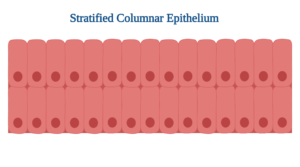Definition of Stratified Columnar Epithelium
The stratified columnar epithelium contains several cell layers, with the apical layer composed of columnar cells and the lower layer composed of cuboidal or columnar cells. The cells with in deeper layers may differ from those in the top layer, like in other stratified epithelium. The position and role of the epithelial tissue influence the alteration of cells just on apical surface. Such epithelium is uncommon yet only occurs in a few places all through the body.
Stratified Columnar Epithelium Structure
- The stratified columnar epithelium is made up of multiple cell layers, with the cells with in deeper layers being uneven and varying in shape. The cells inside the apical layer, on the other hand, have a columnar shape.
- As with basic columnar epithelium, the cells of stratified columnar epithelium are higher than they really are broad.
- Cells within epithelium are compact together, guaranteeing no gaps among them and assisting in their protective role.
- Likewise, to preserve the structural stability of the epithelium, cells are attached to one another via gap junctions, adhesions, as well as desmosomes.
- Just the lowermost basal layer of the stratified epithelium is joined to the basement membrane, whereas the remaining layers are linked to each other.
- Once the cells in the basal layer split, extra cells develop layers on top of the basal layer, resulting in stratified epithelium.
- Cells on the highest layer or the layer closest to the lumen eventually die or are removed from the body off, then new cells develop, resulting in new layers.
- Apical layer cells include complexes of gap junctions as well as desmosomes that operate as filtering agents, filtering unwanted particles out from the cells.
- Epithelium itself does not have blood supply and rather obtains nutrients, water, as well as oxygen through diffusion from the underlying vasculated tissues.
- Nevertheless, the epithelium has its own nerve supply.
Stratified Columnar Epithelium Functions
Stratified epithelium is made up of numerous cell layers which help to protect the underlying tissues. Furthermore, depending on the area of the tissues, they execute a restricted secretion role.
Protection
- Protection is the fundamental purpose of stratified epithelium.
- Since the epithelium is composed of many layers, it helps in protecting the underlying tissues as well as internal organs from a variety of physical and microbiological insults.
- Columnar epithelium of the eyes preserves the conjunctiva as well as other sensitive structures within the eyes.
- Cells’ gap junctions as well as desmosomes form an impenetrable coating that prevents foreign particles from entering.
- At about the same time, this epithelium serves as a gatekeeper, filtering out undesired particles yet enabling water and nutrients to enter the cells.
- Since the cells are constantly replenished as well as healed, they serve as the body’s first line of protection.
Secretion
- The excretory system’s stratified columnar epithelium and glands fulfil the role of secreting waste materials into the ducts and out of the body.
- Likewise, mucus is secreted by the columnar epithelium with in conjunctiva of the eyes for keeping the eyes moist as well as clean.
Examples of Stratified Columnar Epithelium and its locations
- The stratified columnar epithelium lines a tiny section of the mucosal membrane of the anus as well as certain parts of the male urethra within excretory system.
- It is present in the endocrine system in vast excretory ducts of glands such as the oesophageal glands.
- Furthermore, stratified columnar epithelium lines certain areas of the conjunctiva of the eyes.
Stratified Columnar Epithelium Citations
- Mescher AL (2016). Basic Histology. Fourteenth Edition. McGraw-Hill Education.
- Tortora GJ and Derrickson B (2017). Principles of Physiology and Anatomy. Fifteenth Edition. John Wiley & Sons, Inc.
- Waugh A and Grant A. (2004) Anatomy and Physiology. Ninth Edition. Churchill Livingstone.
- https://pediaa.com/difference-between-simple-and-stratified-epithelium/
- https://www.coursehero.com/file/p7a6p5d/In-contrast-stratified-squamous-epithelium-of-the-mouth-is-composed-of-living/
- https://www.ncbi.nlm.nih.gov/pmc/articles/PMC1571515/
- https://www.lab.anhb.uwa.edu.au/mb140/CorePages/Epithelia/epithel.htm
- https://lab.anhb.uwa.edu.au/mb140/CorePages/Urinary/urinary.htm
- https://en.m.wikipedia.org/wiki/Microglia
- https://courses.lumenlearning.com/wm-biology1/chapter/reading-cell-junctions-in-plant-cells/
- https://biologydictionary.net/stratified-squamous-epithelium/
Related Posts
- Phylum Porifera: Classification, Characteristics, Examples
- Dissecting Microscope (Stereo Microscope) Definition, Principle, Uses, Parts
- Epithelial Tissue Vs Connective Tissue: Definition, 16+ Differences, Examples
- 29+ Differences Between Arteries and Veins
- 31+ Differences Between DNA and RNA (DNA vs RNA)
- Eukaryotic Cells: Definition, Parts, Structure, Examples
- Centrifugal Force: Definition, Principle, Formula, Examples
- Asexual Vs Sexual Reproduction: Overview, 18+ Differences, Examples
- Glandular Epithelium: Location, Structure, Functions, Examples
- 25+ Differences between Invertebrates and Vertebrates
- Lineweaver–Burk Plot
- Cilia and Flagella: Definition, Structure, Functions and Diagram
- P-value: Definition, Formula, Table and Calculation
- Nucleosome Model of Chromosome
- Northern Blot: Overview, Principle, Procedure and Results

















